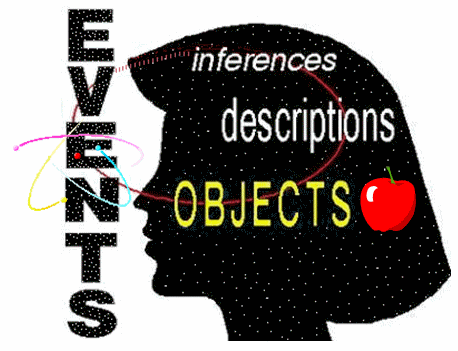
Orders of Abstractions
Written by Steven Lewis, 1996.The reactions of biological critters to their environment is one of non-allness. We cannot know all, see all or even be all things to all people. Our knowledge of the world is not the same as the world itself ... they are not identical. We emphasize this non-allness relationship in general semantics through the term "abstraction." Our relationship to our environment is one of abstraction.
An analogy I use to describe abstracting to my classes relates to a cafeteria line. You select some foods and leave others behind. The foods you select depend on your cultural history, aesthetic values, nutritional knowledge, what you ate for breakfast .... A person who was raised in Mexico would select a different assortment of foods than one raised in Southeast Asia. When we select, we leave behind other foods. What we select, therefore, can be labelled an abstraction. Abstracting involves non-allness as well as one's preferences etc.
Suppose you were to make a statement about the weather. "I love this weather!" We could consider the statement as an abstraction of order n. You left out the annoying fly buzzing around your head; you left out the fact that you are a bit overweight; you left out what was going on in the neighbor's yard across the street etc. Chances are if you had a hangover from the previous night you would not evaluate the weather quite so glowingly anyway. Now let us say you make a statement about the statement. "I said I love this weather!" The second statement is an abstraction of order n+1. At first glance it may not seem obvious how this statement of second order leaves out information, yet it does. The second statement reported only what you had said earlier. Like the first statement it did not report on the fly buzzing around your head, or what the neighbors had been doing across the street, or the degree of contraction of your orbicularis oculi muscles when you made the statement, nor does it report on events that had since changed. Therefore, we can consider the second verbal abstraction as another example of leaving data out.
Suppose we calculated the average age (arithmetic mean) of all the members of a group. Let's say the average comes out to be 38. This number, 38, does not report what you or I are wearing now; it doesn't even tell us what your or my age is. In other words, 38 tells a little bit about the group, but virtually nothing about any individuals in the group. We can label it an abstraction from the group.
Fundamentally when we abstract we leave data out, both consciously and unconsciously. We also tend to fill in data that were not abstracted. Doing this produces inferences. For example, suppose I draw 3 points (A,B,C) that represent 3 cities, and I tell you that an inch represents 30 miles. Then I ask you to determine how long it would take to drive from city A to city C.
A B C
Without knowing other information you might try to measure the linear distance between A and C to calculate the distance. Notice, though, that you are filling in information that you were unable to abstract. You inferred that the highways that connect these cities did so in a linear fashion. Maybe there was a mountain range between A and B that you would have to drive around.
When physicists produce theories about the 'insides' of the atom, they abstract what they can with the help of their instruments, and then connect the dots. Their theories, therefore, are very high order abstractions loaded with assumptions. Their theories are so abstract that they say nothing about the location of any particular atom at a given moment, only about the general structure of an atom of a particular type. Fortunately, unlike T.C. Mits, physicists usually attempt to test their theories with future refined observations (experiments) and discard theories more readily if found deficient.

In biology lab we have several turtles in an aquarium. I ask my students to observe as I bring my hand to the side of the turtle aquarium and tap on the side. The turtles are unperturbed. Next I bring my hand up over the top of the aquarium and the turtles become extremely agitated.
Few students record the events in a manner that I would label a description ... that is, report the raw data of their experiences. "The turtles made no obvious response to the instructor's hand when it approached from the side, but when it approached from the top the turtles attempted to move away." Instead, they jump to conclusions ... that is, connect the dots or fill in data that was not abstracted, such as "You scared the turtles and they want to get to a safe place." I proceed to point out the differences between descriptions and inferences. Descriptions, as lower order verbal abstractions, make little attempt to connect the dots. Inferences attempt to connect the dots ... to fill in data not abstracted. The point of the experiment is to demonstrate how we can evaluate events differently if we are conscious of abstracting, and how we routinely (and usually unconsciously) make assumptions when we abstract.
One credible explanation (inference) for the turtle's differential response to my hand approaching from the side compared to my hand approaching from the top is that the turtle's natural predators include birds like hawks. And these predators usually approach quite suddenly from overhead and take off with the turtle. Hiding in their shell in itself is not an effective protective strategy.
Go to General Semantics Home Page ||| Go to Steven Lewis Home Page